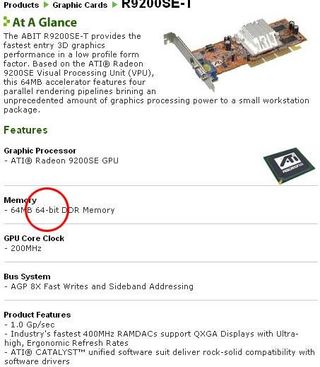THG Graphics Card Buyer's Guide
The Purchase
Once you've picked out the right model, it's time to clear the next hurdle, namely the purchase itself. Again, there is a lot to consider. First, you need to decide whether you want to order online or buy at a local store. On the whole, online shops tend to offer lower prices, but make sure to check out the cost of shipping and handling! Many online retailers charge a premium, and that would-be bargain can turn out to be more expensive than it would have been at your local store.
Buying at a store can also offer some other advantages, especially if you can get competent advice from the employees. If you're lucky, your local store may even let you test the card in the showroom, so you can check out the 2D signal quality of the VGA output, for example. This is an especially important factor in the case of low-cost models.
The main thing to remember is to closely scrutinize the particulars of the offer in question. If information on the card's memory and core frequencies is conspicuously absent, it's best to keep looking! An exact listing of the card's specifications is the least a customer should expect. Frequently, even a scan of the manufacturer's spec sheet may not be of any help. Especially in the low-cost sector, many manufacturers just don't give detailed information on their cards' clock speeds or memory bus width, as the following pictures show:

Abit's data sheet for the Radeon 9200SE-T shows quite detailed information on the card's specifications, with only the clock speeds missing. The note about the slower 64 bit memory is particularly important.

MSI does the exact opposite. Not only are the clock speeds not to be found anywhere, a reference to the slow 64 bit memory is also absent. Instead, the spec sheet only gushes about the memory size of 128 MB - which has practically no beneficial impact on the performance of a card in this category.
If you already have all of the information you need about your dream card, you can search for the best prices online by using search engines such as stores.tomshardware.com . If you've already had a positive experience with an online shop, it may pay off to check if they have the card you're looking for, even if it is slightly more expensive there. Also, always make sure to check the availability of the card! Often, shops will list cards that they don't have in stock. In the worst case, you may end up waiting for your card for weeks or even months.
If you're unsure whether the card you've picked out is the right model, would like to take a look at the card before you buy or have questions about the installation of the card, you're better off going to a store - assuming you find one that offers competent advice.
Stay on the Cutting Edge
Join the experts who read Tom's Hardware for the inside track on enthusiast PC tech news — and have for over 25 years. We'll send breaking news and in-depth reviews of CPUs, GPUs, AI, maker hardware and more straight to your inbox.
Most Popular

